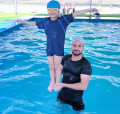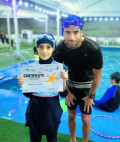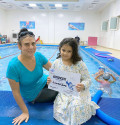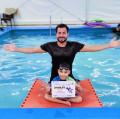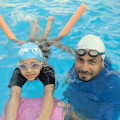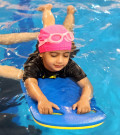
Kick-Boxing workout for kids
2023-08-21 - SwimmingTeaching kickboxing to kids can be a rewarding and beneficial endeavor. However, it's important to prioritize safety, age-appropriate techniques, and proper instruction. Here's a step-by-step guide to help you create an effective and responsible kickboxing learning program for kids:
1. Safety First:
Prioritize safety above all else. Make sure the training area is free from hazards and has adequate padding.
Ensure that kids wear appropriate protective gear, including gloves, mouthguards, shin guards, and headgear.
2. Qualified Instructor:
Hire or become a certified kickboxing instructor with experience in teaching children.
Your instructor should have a background in martial arts, experience with kids, and an understanding of child development.
3. Age-Appropriate Techniques:
Kids' kickboxing should focus on basic techniques such as stance, footwork, punches, and basic kicks.
Avoid high-impact and complex techniques until kids have developed proper form and control.
4. Warm-up and Stretching:
Begin each session with a warm-up to prevent injuries. Include light cardiovascular exercises and dynamic stretches.
5. Basics and Fundamentals:
Teach proper stance, balance, and footwork.
Start with basic punches like jabs and crosses, and basic kicks like front kicks and roundhouse kicks.
6. Focus on Discipline and Respect:
Teach kids the importance of discipline, respect for themselves and others, and self-control.
Emphasize that kickboxing is a form of self-defense and should not be used to harm others outside of the training environment.
7. Gradual Progression:
Progress gradually, increasing the complexity and intensity of techniques as kids improve.
Incorporate partner drills and light sparring only when students are ready and have demonstrated control.
8. Fun and Engagement:
Keep the sessions enjoyable by incorporating games, challenges, and interactive activities.
Use positive reinforcement and praise to motivate kids.
9. Focus on Fitness:
Emphasize the fitness aspect of kickboxing, promoting cardiovascular health, strength, flexibility, and coordination.
10. Communication with Parents:
Maintain open communication with parents or guardians about the program's goals, safety measures, and progress.
Address any concerns or questions they may have.
11. Anti-Bullying and Conflict Resolution:
Teach kids the importance of using their skills responsibly and avoiding physical confrontation outside of the gym.
Incorporate discussions about conflict resolution and standing up against bullying.
12. Nutritional Awareness:
Educate kids about the importance of proper nutrition for their overall well-being and energy levels.
Remember that the primary goal of teaching kickboxing to kids should be their physical fitness, self-confidence, discipline, and self-defense skills. Always create a safe and inclusive environment where all children feel welcome and respected..







.jpg)








































































